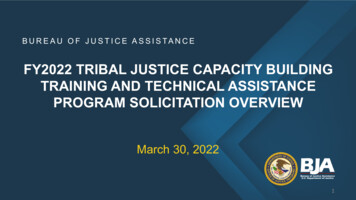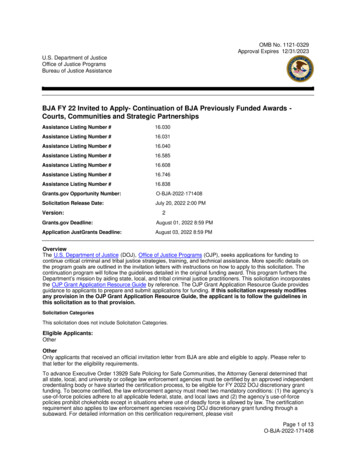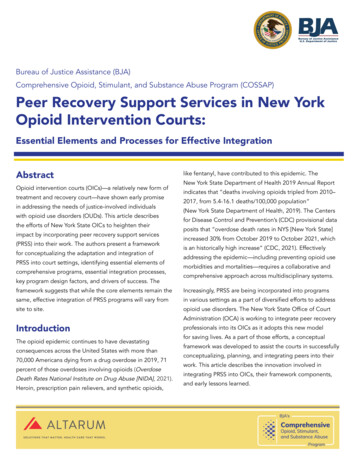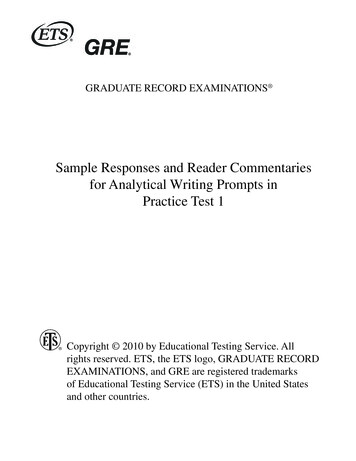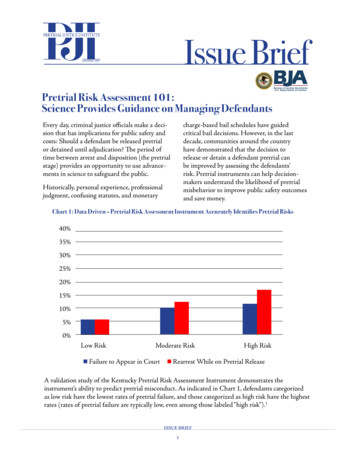
Transcription
Issue BriefPretrial Risk Assessment 101:Science Provides Guidance on Managing DefendantsEvery day, criminal justice officials make a decision that has implications for public safety andcosts: Should a defendant be released pretrialor detained until adjudication? The period oftime between arrest and disposition (the pretrialstage) provides an opportunity to use advancements in science to safeguard the public.Bureau of Justice AssistanceU.S. Department of Justicecharge-based bail schedules have guidedcritical bail decisions. However, in the lastdecade, communities around the countryhave demonstrated that the decision torelease or detain a defendant pretrial canbe improved by assessing the defendants’risk. Pretrial instruments can help decisionmakers understand the likelihood of pretrialmisbehavior to improve public safety outcomesand save money.Historically, personal experience, professionaljudgment, confusing statutes, and monetaryChart 1: Data Driven – Pretrial Risk Assessment Instrument Accurately Identifies Pretrial Risks40%35%30%25%20%15%10%5%0%Low RiskModerate RiskFailure to Appear in CourtHigh RiskRearrest While on Pretrial ReleaseA validation study of the Kentucky Pretrial Risk Assessment Instrument demonstrates theinstrument’s ability to predict pretrial misconduct. As indicated in Chart 1, defendants categorizedas low risk have the lowest rates of pretrial failure, and those categorized as high risk have the highestrates (rates of pretrial failure are typically low, even among those labeled “high risk”).1ISSUE BRIEF1
1. What is a pretrial risk assessmentinstrument?tion is based on differences in statutes, data quality,availability of supervision resources, etc. It is important to validate any instrument on your populationand revalidate on a regular basis.A pretrial risk assessment instrument is typicallya one-page summary of the characteristics of anindividual that presents a score correspondingto his or her likelihood to fail to appear in courtor be rearrested prior to the completion of theircurrent case. Instruments typically consist of 7-10questions about the nature of the current offense,criminal history, and other stabilizing factors suchas employment, residency, drug use, and mentalhealth.23. Why is it important to knowsomeone’s risk level?A person’s risk level should be used to guide twodecisions: 1) the decision to release or detain pretrial, and 2) if released, the assignment of appropriate supervision conditions. While the chargefor which someone was arrested is important inthese decisions, the charge alone does not informyou of someone’s likelihood to make all court appearances or his or her risk to public safety.Responses to the questions are weighted, basedon data that shows how strongly each item isrelated to the risk of flight or rearrest duringpretrial release. Then the answers are tallied toproduce an overall risk score or level, which caninform the judge or other decisionmaker aboutthe best course of action.Research has shown that intensive supervisioncan work well with some higher-risk individuals,but it usually results in poor outcomes for peoplewho have been assessed to be lower risk.4The other reason to know someone’s risk scoreis to make the best use of scarce resources. It is awaste of money to over-condition people who donot need those conditions in order to comply. Itis a good use of money to provide supervision inthe community to someone who needs it, whencompared to the cost of housing, feeding, andproviding medical care in jail. Supervision cancost between 3- 6 a day. Jail (housing, feeding,medical care) can cost roughly 50 a day.2. What risk factors are on a pretrial riskassessment instrument?Unlike other risk/needs assessments, the pretrial risk assessment instrument contains factorsthat are associated with increased chances ofonly two types of failure during a short periodof time: failure to appear for all court hearingsand rearrest on a new charge. Typically, instruments weigh such factors as nature of the currentcharge, any pending charges, number of priorconvictions resulting in jail time, prior violentconvictions, failure to appear history, residentialstability, employment/caregiver history, and drugabuse history.3Most jurisdictions have bond schedules, whichbase a dollar amount set for pretrial release onthe charge for which the person was arrested.These schedules do not have any mechanism totake into account the individual risks posed bya defendant, and often they permit someone tobond out prior to being screened for risk.Which factors are predictive, and the weight of eachrisk factor, varies by jurisdiction. Some of this varia-A PUBLICATION OF THE PRETRIAL JUSTICE INSTITUTE2
4. How effective are pretrial riskassessment instruments?ment showed its efficacy by demonstrating thatlow-risk individuals had a 92.9% success rate,average-risk individuals had an 82.2% successrate, and high-risk individuals had a 68% successrate.6Pretrial risk assessment instruments are highlyeffective in their ability to predict rates of successon pretrial release (return to court and no newarrests while on release). Numerous studies haveshown that validated pretrial risk assessmentscan accurately differentiate defendants’ risk.5In the federal system, all 94 districts use a standardized instrument developed using their data. Chart2 shows the outcomes, with Risk Category 1 beingthe lowest risk and Risk Category 5 being thehighest. Those scored as Risk Category 5 still havereasonable outcomes when released pretrial withappropriate conditions of supervision.7The Virginia Risk Assessment Instrument usesa low/below average/average/above average/high scale to predict risk. A study of that instru-Chart 2: U.S. Pretrial and Probation, Federal Pretrial Risk Assessment(FTA Failure to Appear; NCA New Criminal Arrest; TV Technical TVRisk Category 1Risk Category 2Risk Category 4Risk Category 5ISSUE BRIEF3Risk Category 3
5. How are pretrial risk assessmentinstruments developed?6. What are the challenges andlimitations of pretrial riskassessment?Risk assessment instruments are developed bycollecting and analyzing local data to determinewhich factors, and to what degree, are predictiveof pretrial risks (failure to appear or rearrest).Careful consideration should be taken whendeveloping an instrument for your jurisdiction. There are a number of model instrumentsthat have been validated in one jurisdiction andadopted by other jurisdictions. In such cases,the jurisdiction collects data and then validatesthe imported tool on their own population. Allinstruments should be revalidated at regularintervals to ensure they retain their predictivevalidity. Differences in bail statutes, court rules,release options available to the court, and otherfactors cause variations from site to site. Statistical analysis on local data helps ensure these aretaken into account.Pretrial risk assessment instruments cannot predict with accuracy a specific individual’s behavior.The tools are research-based guides to takingrisks. There will be lower-risk individuals whofail on pretrial release, and there will be higherrisk individuals who succeed. However, theseinstruments provide an objective, standard wayof assessing the likelihood of pretrial failure thatresearch shows produces higher accuracy thansubjective assessments by even the most experienced and well-respected decisionmakers.This does not mean that pretrial risk assessmentinstruments should be used in place of professional discretion. The instrument produces ascore that can help anchor a decision, and deviations (overrides) can be expected and the reasonsshould be documented.There are a number of ways to accomplish thedevelopment of a locally valid instrument. Localuniversities and researchers may have the capacity to develop an instrument at reasonable cost.The U.S. Department of Justice may provideassistance under grant programs such as JusticeReinvestment or through their technical assistance programs.The pretrial risk assessment instrument is anappropriate tool for an in/out custody decisionbased on risk. Other instruments are available tohelp identify areas of need that should be addressed during supervision (such as the need formental health or substance abuse assessments).Finally, the instrument must be consistentlyvalidated to ensure its predictive validity. For thisto happen, jurisdictions must collect a variety ofdata about defendants, including if/how they arereleased pretrial, the quality and quantity of supervision conditions, their pretrial behavior, andthe adjudication of their case. This data can helpidentify any other predictive factors for pretrialsuccess, which programs can use to improve.A PUBLICATION OF THE PRETRIAL JUSTICE INSTITUTE4
7. What can stakeholders do?Ohio and Indiana: In 2009, researchers fromthe University of Cincinnati used Ohio data todevelop a set of risk assessment instruments to beused throughout the criminal case process, including pretrial.8 The instruments are publicly availableand formed the basis for a similar project completed in 2010 for Indiana.9Criminal justice stakeholders – from electedcounty officials and sheriffs to judges and prosecutors – are putting research into action. Theyare collaborating to ensure that their policies andprocedures match research to produce the bestand most cost-effective outcomes. Over the lastfew years, jurisdictions have undertaken reviewsof pretrial policies and procedures and implemented pretrial risk assessment instruments. Forexample:Mecklenburg County, NC: In 2010, the countyimplemented a pretrial risk assessment instrument and a research-based matrix of supervisionconditions matched to risk levels. As a result,they reduced the average daily population of thejail by 33 percent.10Kentucky: Because of their successful use ofpretrial risk assessment instruments to keeponly those who need to be detained pretrial andsuccessfully manage other defendants undercommunity supervision, Kentucky’s legislaturemandated the use of the instrument prior to firstappearance in the Public Safety and Offender Accountability Act of 2011 (HB463).For more information please contact John Clark,Senior Project Associate of the Pretrial JusticeInstitute, at john@pretrial.org or by calling 202638-3080 extension 301. You may also contactKim Ball, Senior Policy Advisor for Adjudicationof the Bureau of Justice Assistance, at Kim.Ball@usdoj.gov or by calling 202-307-2076.EndnotesAgency, Inc. VanNostrand, M. (2003). Assessing Risk AmongPretrial Defendants in Virginia: The Virginia Pretrial Risk Assessment.Richmond, VA: Virginia Department of Criminal Justice Services.1 Austin, J., Ocker, R., Bhati, A. (2010). Kentucky Pretrial RiskAssessment Instrument Validation. Washington, D.C.6 VanNostrand, M. and K. Rose (2009). Pretrial Risk Assessmentin Virginia. Richmond, VA: Virginia Department of CriminalJustice Services.2 Mamalian, Cynthia A. (2011). State of the Science of Pretrial RiskAssessment. Washington, D.C.: Pretrial Justice Institute.3 Ibid.7 Lowenkamp, Christopher. (August 2011). Risk Assessment andEvidence Based Practices in Pretrial. Presentation to NIC PretrialExecutives Orientation. Colorado.4 VanNostrand, M., and G. Keebler (2009). Pretrial Risk Assessment in Federal Court. Federal Probation. Vol. 73 (2).8 Latessa, Edward, Paula Smith, Richard Lemke, Matthew Makarios, and Christopher Lowenkamp (2009). Creation and Validation of the Ohio Risk Assessment System: Final Report. Cincinnati,Ohio: University of Cincinnati.5 Clark, J. and D. Levin (2007). The Transformation of PretrialServices in Allegheny County, Pennsylvania: Development of Best Practices and Validation of Risk Assessment. Washington, D.C.: PretrialJustice Institute. Podkopacz, M. (2006). Fourth Judicial District ofMinnesota Pretrial Evaluation: Scale Validation Study. PowerPointPresentation. Siddiqi, Q. (2006). Predicting The Likelihood of PretrialRe-Arrest for Violent Felony Offenses and Examining the Risk ofPretrial Failure Among New York City Defendants: An analysis ofthe 2001 dataset. New York, NY: New York City Criminal Justice9 University of Cincinnati (2010). Indiana Risk AssessmentSystem.10 VanNostrand, Marie. “Using Evidence to Advance EffectiveJustice Realignment Pretrial.” California Realignment Conference,21 September 2011. Conference Presentation.This project was supported by Grant No. 2010-DB-BX-K034 awarded by the Bureau of Justice Assistance. The Bureau of Justice Assistance is acomponent of the Office of Justice Programs, which also includes the Bureau of Justice Statistics, the National Institute of Justice, the Office of Juvenile Justice and Delinquency Prevention, the Office for Victims of Crime, and the Office of Sex Offender Sentencing, Monitoring, Apprehending,Registering, and Tracking. Points of view or opinions in this document are those of the author and do not necessarily represent the official positionor policies of the U.S. Department of Justice.ISSUE BRIEF5
Risk Assessment and Evidence Based Practices in Pretrial. Presentation to NIC Pretrial Executives Orientation. Colorado. 8 Latessa, Edward, Paula Smith, Richard Lemke, Matthew Ma-karios, and Christopher Lowenkamp (2009). Creation and Valida-tion of the Ohio Risk Assessment System: Final Report. Cincinnati, Ohio: University of Cincinnati.

